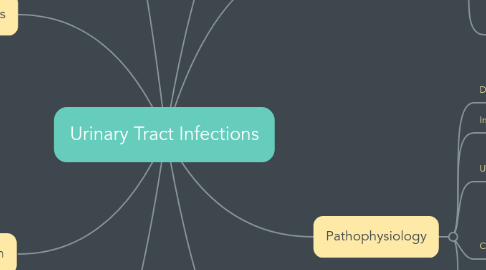
1. Symptoms
1.1. Persistent urge to urinate
1.2. Dysuria - pain while urinating
1.3. Burning sensation when urinating
1.4. Strong-smelling urine
1.5. Pyuria - cloudy urine caused by white blood cells in the urine
1.6. Pelvic pain
1.7. Hematuria - blood in urine
2. Diagnostics
2.1. Urine Collection
2.1.1. Collected by clean catch or catheterization of patient
2.1.2. Testing after collecting the urine should not be done after 2 hours of collecting urine because test results may not be accurate. Urine can be refrigerated to preserve the sample
2.2. Urine Testing
2.2.1. Microscopic Examination
2.2.1.1. A UTI can be diagnosed from a microscopic exam if 2 to 5 white blood cells per high-power field are found (pyuria)
2.2.1.2. Blood in urine (hematuria) can be observed from a microscopic exam
2.2.2. Dipstick Test
2.2.2.1. Positive nitrite test on fresh specimen is highly specific for diagnosing a UTI
2.2.2.2. Leukocyte esterase test is very specific for the presence of white blood cells and is sensitive
2.2.3. Cultures
2.2.3.1. Recommended in patients whose symptoms suggest a complicated UTI
2.2.3.1.1. Pregnant women
2.2.3.1.2. Postmenopausal women
2.2.3.1.3. Men
2.2.3.1.4. Children
2.2.3.1.5. Patients with functional or structural abnormalities of urinary tract
2.3. Other
2.3.1. Very ill patients will be tested for the presence of sepsis
3. Body System
3.1. Urinary
3.2. Renal
4. Assessment
4.1. COLDSPA - pain scale
4.2. Subjective data
4.2.1. History of frequent UTI
4.2.2. Sexual activity
4.2.3. Pain or burning sensation when urinating
4.2.4. Blood in urine
4.2.5. Cloudy urine
4.2.6. Flank or pelvic pain
4.2.7. Proper perineal care
4.3. Objective data
4.3.1. Palpate lower abdomen and ask if patient feels discomfort or pain
4.3.2. Palpate kidneys for edema or pain
4.3.3. Urine collection
4.3.4. Check patient for fever
4.3.5. Exam of patient’s perineal area
5. Functional Health Pattern
5.1. Elimination
6. Nursing Diagnosis
6.1. Actual
6.1.1. Altered urinary elimination related to infection
6.1.2. Infection related to urinary retention as evidence by pyuria
6.1.3. Acute pain related to inflammation of urinary tract epithelium as evidence by dysuria
6.1.4. Deficient knowledge related to unfamiliarity with treatment of a UTI as evidence by recurrent UTI
6.2. Risk
6.2.1. Risk for infection (cystitis or pyelonephritis) as evidence by dysuria and flank pain
6.2.2. Risk for disturbed sleep pattern related to nocturia as evidence by restlessness and irritability
7. Pathophysiology
7.1. Defined as an inflammation of the urinary epithelium that is caused by bacteria, typically Escherchia coli
7.2. In some cases, if the UTI is left untreated, the infection can spread to the bladder, causing cystitis, or to the kidneys, causing pyelonephritis
7.3. Uncomplicated UTI
7.3.1. Typically occurs in premenstrual women with no structural or functional abnormality in the urinary tract or bladder
7.4. Complicated UTI
7.4.1. Involves either gender at any age
7.4.2. Caused by a structural or functional abnormality within the person’s urinary tract or bladder
7.4.3. Can also be caused by diabetes, chronic kidney disease, immunocompromise, or recent surgery to the urinary tract
7.5. The majority of UTIs occur when bacteria enter the urinary tract and can then travel to the bladder and kidneys
7.5.1. E. coli, the bacteria entering the urinary tract, is more easily able to reach the urethra in women due to the smaller distance from the anus to the urethra
7.5.1.1. Causes include wiping from back to front or not urinating after sexual activity or intercouse
7.5.2. Escherichia coli is a bacteria found in the intestines and rectum of humans. While this bacteria is good for the GI tract, it can cause major problems if exposed to the urinary system
8. Treatment
8.1. Antibiotics
8.1.1. 3-day or 7-day antibiotic often prescribed to rid the urinary tract of the bacteria present
8.2. Surgery
8.2.1. For more extreme cases where abscesses needed to be drained or an obstruction has to be removed
